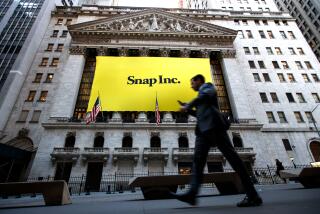Spectacles might get the buzz, but for investors Snapchat is all about the advertising

- Share via
The company behind Snapchat has two offerings — that beloved, 5-year-old app for messaging and video streaming, and Spectacles, a months-old, $130 pair of sunglasses that double as a camcorder.
The Los Angeles company has promised more gadgets will follow. But even with a significant increase, hardware sales in the near term probably would bring in 100 times less revenue than selling ads displayed on Snapchat.
It’s that potentially massive, multibillion-dollar ad business that has investors most excited about Snap Inc., which is expected to open its stock to public trading in the coming weeks in one of the tech industry’s highest-anticipated initial public offerings in years.
So why is Snap insisting it’s actually a camera company?
The label introduced last year raised questions about Snap’s hardware ambitions. But more than signaling that Snap is the next Apple Inc. — a firm that makes software and hardware but derives about two-thirds of its revenue from iPhone sales — the distinction could be an attempt to help investors see the nuance between the goals of Snapchat and those of its most potent rival, Facebook.
Unlike Facebook, Snap’s not out to connect everyone on the planet. Rather, its goal is to tinker with both the physical make of cameras and the code behind them, giving people new ways to chat with friends, have fun together and educate themselves about the world. Both companies rely on advertising revenue, but Snap, which declined to comment, appears to be suggesting its approach will be more focused.
“They need to show they are not just Facebook for teens,” said Gene Munster, who studied Apple’s finances for years and now co-manages investment firm Loup Ventures. Tech companies that enjoy the most sustained success have visions beyond what’s visible to most today, and Snap is arranging itself to join that group.
“Twenty years from now, the way we engage with the world will probably not be a phone,” Munster said. “Hardware changes are going to be happening, and this mission gives them a foothold and foundation to be prepared for this transition.”
Though the camera, both in apps and in gadgets, will be central to that aim, investors and the financial analysts who advise them ascribe minimal value to Spectacles and other hardware. They insist Snap’s real value is in the advertising business. If Snap wishes otherwise, it will have a long way to go before changing perceptions.
“I would be hard-pressed to imagine them as a hardware company unless it’s possible to see a long-term commitment to that business,” said Brian Wieser, who follows companies such as Facebook for Pivotal Research. “So for now, it’s an ad tech company.”
Still, Snap joins financial technology company Square Inc. as one of the first Internet companies with revenue coming from both hardware and software at the time of an initial public stock offering. That split helps diversify its business, but it means Snap also will have to justify to investors any hardware-related expenses.
Snap has shared limited financial data with potential investors and met only with a select group of analysts. More could become clear when it publicly shares its stock prospectus, which could be as early as this week.
Experimentation doesn’t necessarily hurt share prices, said Scott Kessler, a financial analyst at CFRA. Amazon.com, Facebook and Google parent company Alphabet Inc. have gotten away with unrealized product goals as their core businesses continue to surge.
“People want to see these companies innovating and trying new things,” Kessler said.
But troubles can arise. For one, hardware can reduce earnings.
“Software is the way to go because that’s a more profitable business,” Kessler said. “Manufacturing things, that’s obviously more challenging from supply chain, cost perspective. It’s a lot different than someone going somewhere and downloading software.”
Still, companies often try to show investors before they go public that they are more than one-trick businesses. Ride-hailing service Uber Technologies Inc. has ventured into self-driving delivery trucks. Short-term rental booking giant Airbnb is trying to help consumers with more aspects of travel planning. Both could go public this year or next.
But companies new to public markets must live up to those promises or risk seeing their value fall.
The faltering shares of GoPro, which closed a much-heralded video-distribution business two years after an IPO, and Twitter, which couldn’t maintain user growth, reflects what happens when reality doesn’t meet expectations. For Square’s part, hardware has grown slightly as a portion of its revenue mix.
If anything, fear that many tech start-ups such as Snap are overvalued has led to more skepticism about second acts in the last year.
Chinese phone maker and social media app developer Meitu has seen its shares barely budge from their initial price since going public a month ago. About 95% of Meitu’s revenue comes from phone sales, and analysts question how fast the software business can grow.

In Snap’s favor is that its second revenue line already has inklings of success. Spectacles have received positive reviews. Investors point to the long lines that Snap generated by selling the sunglasses through roving vending machines. It’s a wacky experience that has energized the industry. And because of Snap’s generally small release of thousands of pairs, investors simply are discounting the idea for now.
“It seems like a noble experiment akin to Google Glass, but not yet a central part of the Snap value proposition,” said Chris Rust, a founder at Clear Ventures who held a board observer role at GoPro.
Instead, Snap’s biggest challenge could be convincing investors to notice the distinctions with Facebook and showing them that profit is within sight.
Alexander Stimpson, co-chief investment officer at Newport Beach money manager Corient Capital Partners, said he’s worried that companies going public before demonstrating recurring profitability have turned investors into speculators. It forces them to invest based on instincts rather than formulas. And despite the great risks, they stand to gain a much smaller return than the venture capitalists who held shares prior to the IPO.
“If a company is unprofitable, the rewards should be substantial because you’re taking substantial risk,” he said.
Because Snap isn’t yet profitable, Stimpson doesn’t mind coming late to the party when it may be a safer bet.
“When there’s no earnings there, it forces investors to behave in a way that’s against their best interests to be successful long term,” he said. “Investors are successful when they are disciplined about valuations, when profits matter, when metrics matter, when they buy low and sell high.”
Still, many analysts expect the excitement to be so great that Snap gets whatever price it wants. Hitting the stock market could bring Snap’s value upward of $25 billion.
“Any time you have a brand-name company, you’re going to have a lot of interest,” said Ivan Feinseth, director of research at Tigress Financial Partners. “They are very strong in the teen, preteen and the millennial market. They’re a key player.”
Twitter: @peard33
ALSO
Mark Zuckerberg is acting like he might run for president
Refugees get jobs — and a taste of American culture — at Berkeley coffee shop
Apple sues Qualcomm for $1 billion, depicting it as a shady monopolist







